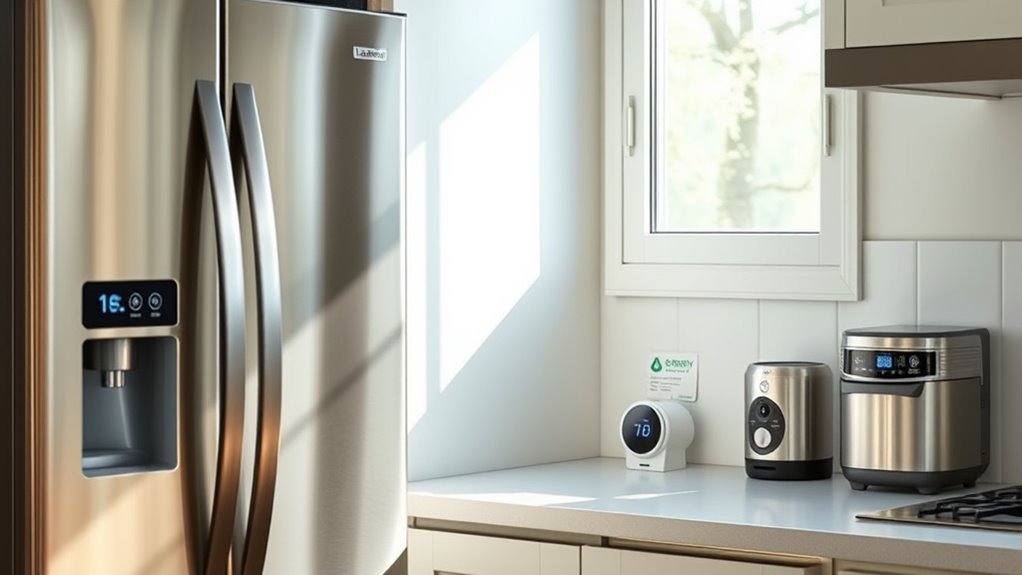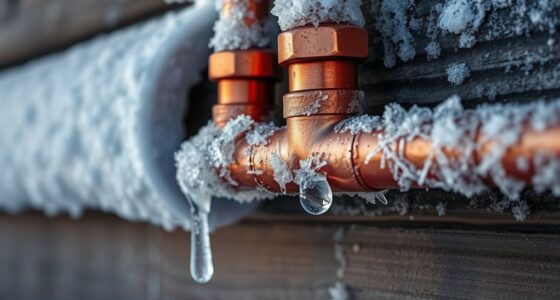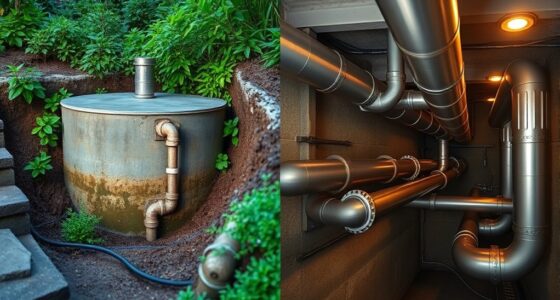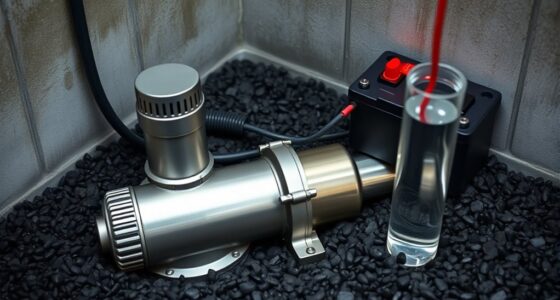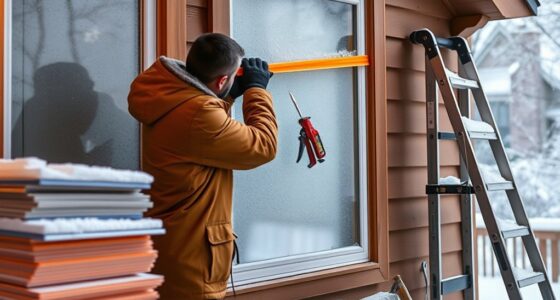To cut your energy bill now, upgrade to ENERGY STAR-certified appliances, as they use 20-30% less energy. Regularly clean and maintain your systems, including HVAC filters, to keep them running efficiently. Use LED bulbs and maximize natural light by opening curtains or installing skylights. Seal air leaks and improve insulation to prevent heat loss or gain. Managing your electricity plan and using smart thermostats can boost savings—keep exploring for more simple tips.
Key Takeaways
- Upgrade to ENERGY STAR-certified appliances to significantly reduce electricity consumption and lower bills.
- Regularly clean and maintain appliances like refrigerators and dishwashers for optimal efficiency.
- Use smart thermostats and schedule HVAC tune-ups to improve system performance and save energy.
- Unplug devices and chargers when not in use to eliminate standby power waste.
- Enhance insulation, seal leaks, and shade windows to reduce heating and cooling energy needs.
Use Energy-Efficient Appliances and Upgrade When Necessary
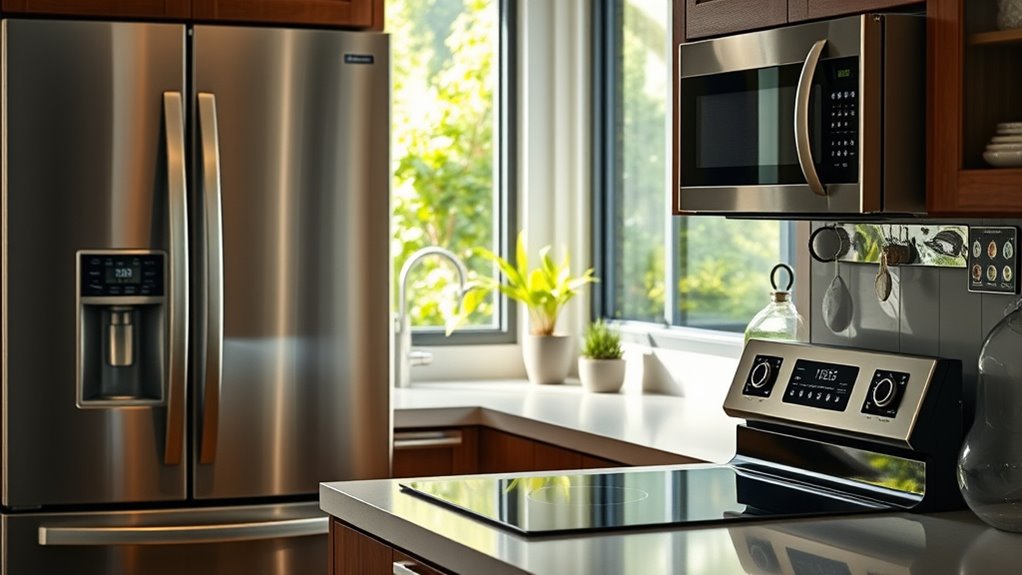
Upgrading to energy-efficient appliances is one of the most effective ways to cut your energy bills and reduce environmental impact. When you choose ENERGY STAR-certified models, you enhance appliance efficiency and achieve significant energy savings. Upgrading your refrigerator, dishwasher, or laundry machines can reduce electricity consumption by 20-30%, directly lowering your utility costs. Plus, federal tax credits of up to 30% make these upgrades more affordable, offsetting initial expenses. Newer appliances operate with advanced technology, helping you reduce greenhouse gas emissions—about 130,000 pounds over their lifespan. To maximize performance and energy savings, remember to perform regular maintenance and replace outdated appliances when necessary. This proactive approach guarantees your home stays energy-efficient and environmentally friendly. Additionally, understanding EnergyGuide labels can help you select the most efficient models and make informed purchasing decisions. Recognizing appliance technology advances can further guide you in choosing the best options for your household. Incorporating smart home devices can also optimize energy use and improve overall efficiency.
Maintain and Optimize Your Heating and Cooling Systems
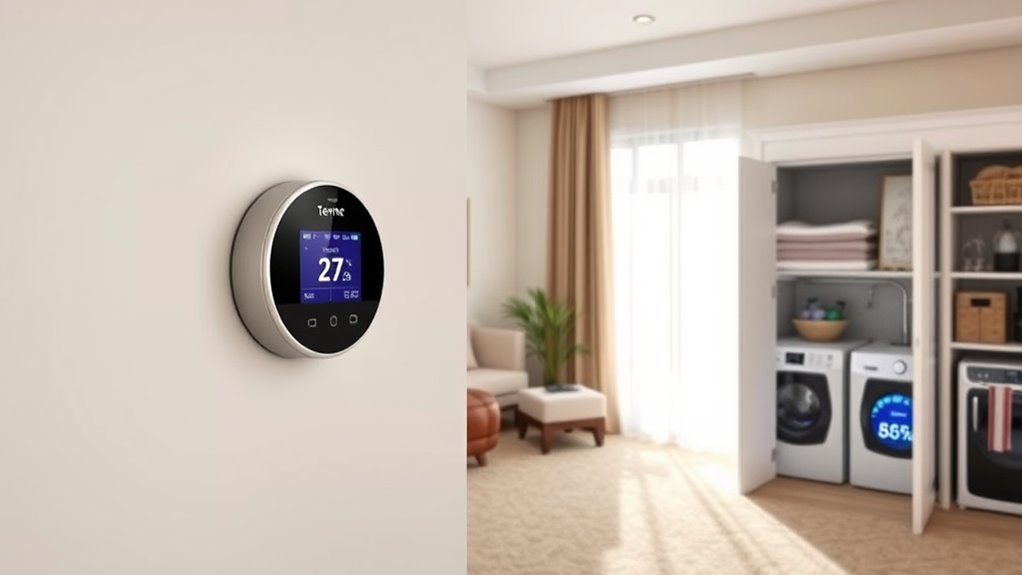
Maintaining and optimizing your heating and cooling systems is essential for maximizing energy efficiency and reducing utility bills. Proper HVAC maintenance guarantees your system performs at its best, saving you money. Regular tune-ups and filter changes improve system performance and air circulation, while sealing leaks enhances energy savings. These simple steps keep your HVAC running smoothly and efficiently. Additionally, considering system upgrades such as modern, energy-efficient equipment can further reduce long-term costs and improve overall comfort. Incorporating lifestyle adjustments, like adjusting your thermostat when you’re away or asleep, can also contribute to significant energy savings over time. Regularly inspecting and cleaning air filters can prevent dust buildup and ensure your system operates at peak efficiency.
Switch to LED Lighting and Maximize Natural Light
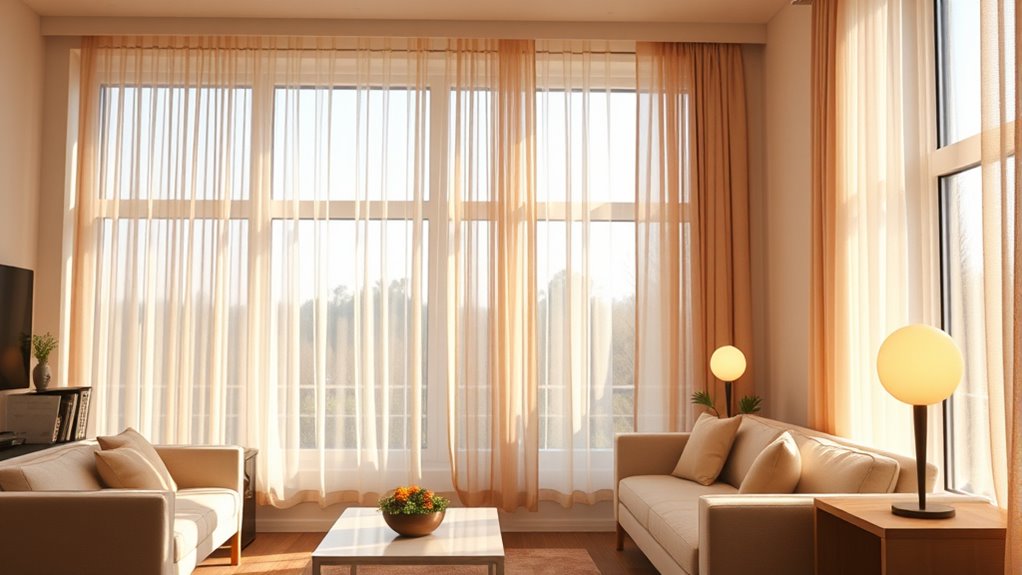
Switching to LED bulbs can cut your lighting energy use by about 75 and last much longer, saving you money in the long run. Making the most of natural light by opening curtains and installing skylights or solar tubes reduces your dependence on electric lighting. By using window coverings wisely, you can keep your home comfortable while maximizing daylight and cutting energy costs. Additionally, understanding home energy efficiency principles can help you identify further opportunities to reduce your overall consumption. Incorporating data analysis of your energy use can reveal patterns and suggest targeted improvements. Focusing on nutritional value of juices can also inspire energy-efficient choices in your diet and lifestyle. Exploring natural methods of detoxification may further enhance your energy savings by reducing reliance on energy-intensive appliances. Being aware of cybersecurity vulnerabilities during outages or increased online activity can help you protect your smart home systems and personal data.
Switch to LED Bulbs
Replacing traditional incandescent bulbs with LED bulbs can cut your lighting energy use by up to 75%, saving you money and reducing environmental impact. These long-lasting, energy-efficient bulbs not only decrease your electricity bill but also require fewer replacements. When you switch to LED bulbs, you improve home lighting while minimizing energy consumption. Imagine:
- Bright, crisp illumination that lasts 25 times longer than incandescent bulbs.
- Lower energy bills thanks to reduced lighting costs.
- Less waste from fewer bulb replacements, helping the environment.
- Local energy-efficient options can further enhance savings and support community sustainability efforts.
- Using energy-efficient lighting is also compatible with other eco-friendly practices, such as maximizing natural light during the day. Incorporating appliance efficiency strategies, like upgrading to energy-efficient appliances, can further reduce your overall energy consumption and bills. Additionally, adopting AI-powered data analytics can help identify the most effective energy-saving practices tailored to your household.
Use Window Coverings Wisely
Using window coverings wisely can substantially reduce your home’s energy consumption by controlling heat gain and loss. Installing curtains or blinds with good insulation, like medium-colored drapes with white backing, helps reflect heat and improve insulation, keeping your home cooler in summer and warmer in winter. During summer, close these coverings on sun-facing windows to block heat and cut cooling costs by up to 77%. Consider adding window film or reflective coatings for solar control, which can block up to 99% of UV rays, reducing heat transfer and cooling expenses. Proper air quality maintenance also ensures your home stays comfortable and healthy year-round. Additionally, choosing energy-efficient window coverings made from insulating materials can further enhance your home’s thermal comfort. In winter, open curtains to maximize natural daylight, providing free warmth and decreasing reliance on heating. Incorporating natural light management strategies can optimize daylight use and further improve energy efficiency. Proper ventilation practices are also important for maintaining good indoor air quality and overall comfort. Being aware of insulation properties of your window treatments can help you select the best options for seasonal efficiency.
Maximize Daylight Usage
Maximizing natural daylight can substantially reduce your home’s reliance on artificial lighting and lower energy bills. To boost daylight intake, consider these tips:
- Open curtains and blinds on south-facing windows during the day to let sunlight flood your rooms, naturally heating and illuminating your space.
- Install skylights or solar tubes to enhance daylight penetration in darker areas without increasing energy use.
- Use energy-efficient LED bulbs for artificial lighting, which can cut lighting energy consumption by up to 75% when daylight isn’t enough.
- Employ lighting controls such as dimmers or timers to optimize artificial light usage and further reduce energy consumption.
- Remember that appliance efficiency plays a crucial role in overall energy savings by reducing unnecessary power consumption.
- Incorporate energy-saving practices, such as scheduling appliance use during off-peak hours, to further cut your energy costs.
Implement Outdoor Landscaping and Shading Strategies

Implementing outdoor landscaping and shading strategies can considerably reduce your home’s cooling costs. By planting shade trees near south-facing windows, you create natural shade that blocks solar heat gain during summer while letting sunlight warm your home in winter. Installing shading devices like awnings or exterior blinds can block up to 90% of solar heat gain, lowering indoor temperatures and cutting cooling energy use. Using landscape features such as shrubbery or trellises with climbing plants offers natural shade barriers that further decrease the need for air conditioning. Properly positioned trees and shading structures can reduce outdoor air temperatures by up to 10°F, minimizing heat entering your home. Maintaining these outdoor elements guarantees ongoing energy savings and enhances your home efficiency, ultimately lowering your energy bills.
Seal Air Leaks and Improve Home Insulation
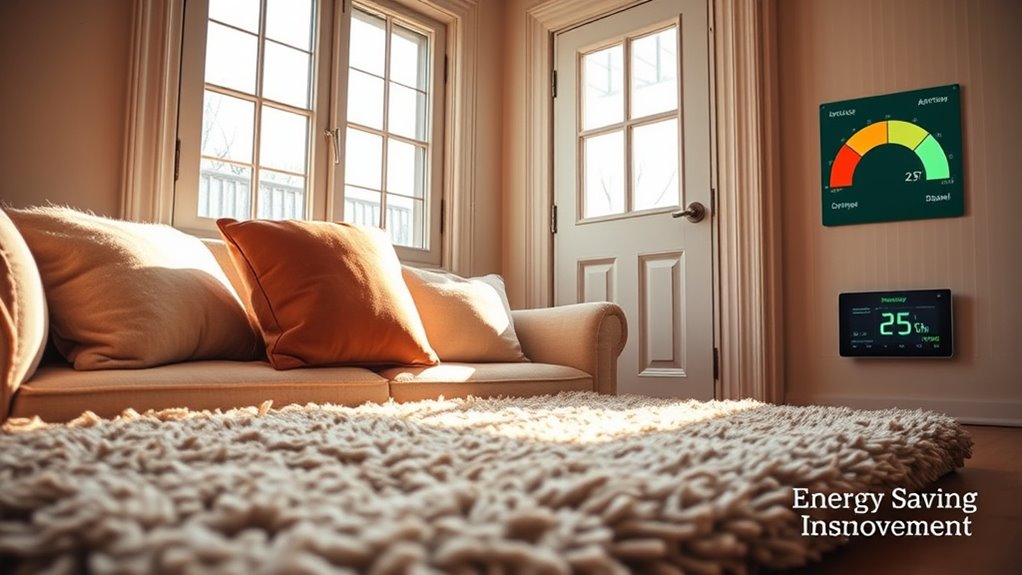
Start by quickly identifying where air leaks are sneaking in around your windows, doors, and vents. Seal these gaps with caulk or weatherstripping to block drafts and save energy. Improving your attic and basement insulation further boosts your home’s ability to stay warm or cool efficiently.
Identify Air Leaks Quickly
Are you aware of how quickly air leaks can sneak into your home and drive up your energy bills? Detecting these leaks early saves money and boosts efficiency. Picture these common trouble spots:
- Gaps around vents or electrical outlets.
- Hidden cracks near your attic or basement.
- Drafty spots along window frames or baseboards.
Using a home energy audit helps identify these leaks and reveals where sealing gaps with weatherstripping or caulking will make the biggest impact. Proper insulation in attics, basements, and crawl spaces complements air leaks detection, reducing energy waste. Regularly inspecting and maintaining your sealing materials ensures long-term energy efficiency. Quickly addressing drafts and leaks prevents unnecessary heat loss, lowering your bills and increasing comfort.
Seal Windows and Doors
Sealing your windows and doors is one of the most effective ways to cut energy waste and boost home comfort. By sealing gaps with caulk or weatherstripping, you can reduce air leaks and drafts, improving insulation and increasing energy efficiency. Properly sealed windows and doors prevent heat loss in winter and keep cool air inside during summer, lowering your heating and cooling costs. Installing weatherstripping is inexpensive—often just $5 to $15—and can make a significant difference in insulation effectiveness. Regularly inspecting and maintaining the seals around your home’s windows and doors guarantees they stay airtight, reducing drafts and preventing unnecessary energy use. This simple step makes your home more comfortable and helps you save money on energy bills.
Boost Insulation Effectiveness
Boosting your home’s insulation effectiveness begins with sealing air leaks around windows, doors, vents, and electrical outlets, which can reduce energy loss by up to 30%. To improve your home insulation and increase energy efficiency, consider these steps:
- Use weatherstripping around doors and windows to block drafts and prevent air leaks.
- Apply caulking to seal gaps around vents, electrical outlets, and window frames for better insulation.
- Insulate attics, basements, and crawl spaces to maintain temperature stability and cut heating and cooling costs.
These simple actions prevent drafts, enhance home insulation, and boost energy savings. Regularly inspecting and upgrading insulation materials will keep your home comfortable and energy-efficient while reducing unnecessary waste.
Manage Your Electricity Plan and Use Time-of-Use Pricing

Managing your electricity plan effectively can lead to significant savings, especially if you take advantage of time-of-use pricing. By choosing the right electricity plan and exploring various rate options, you can lower your energy costs and reduce utility bills. Online tools like MD Electric Choice or Energize CT make it easy to compare plans and find rates as low as 8 cents per kWh, saving hundreds annually. Paying attention to peak hours and scheduling energy-heavy tasks during off-peak times can reduce costs by 20-30%. Regularly reviewing your utility bills helps identify savings opportunities and ensures you’re leveraging the most cost-effective plans. Managing your electricity plan with these strategies boosts energy efficiency and makes your energy expenses more predictable and affordable.
Adopt Smart Thermostats and Proper HVAC Maintenance
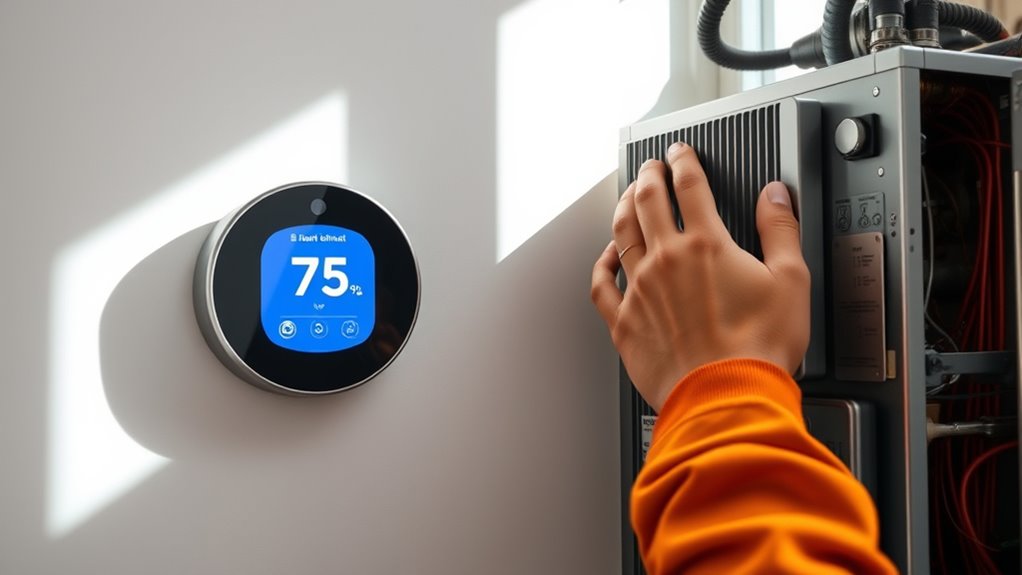
Installing a smart thermostat and maintaining your HVAC system regularly can substantially cut your energy bills. Smart thermostats, like ENERGY STAR models, optimize temperature settings through automatic adjustments and programmable schedules, helping you reduce heat when it’s unnecessary. Features like geofencing detect your presence, adjusting the temperature accordingly. Regular HVAC maintenance—such as filter changes and system tune-ups—boosts efficiency by 5-15%, extending your system’s lifespan. Consider these steps to maximize savings:
- Use smart thermostats to set and adjust temperatures remotely.
- Schedule system tune-ups to keep your HVAC running smoothly.
- Enable geofencing to automatically lower heating or cooling when you’re away.
These practices guarantee better energy efficiency and lower your bills effortlessly.
Practice Energy-Saving Habits With Appliances and Electronics
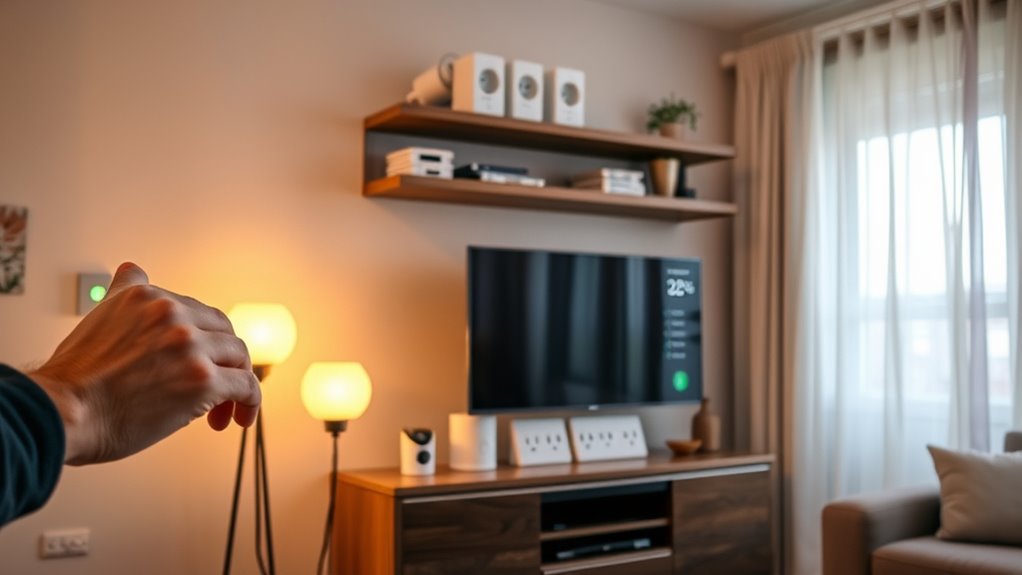
Practicing energy-saving habits with your appliances and electronics can substantially reduce your household energy bills. To improve efficiency and cut costs, always unplug devices and chargers when you’re not using them to eliminate standby power, which can account for 5-10% of your energy use. Use smart power strips or timers to automatically cut power to idle electronics like TVs, computers, and gaming consoles, reducing unnecessary energy consumption. Regularly cleaning and maintaining appliances such as refrigerators and dishwashers ensures they operate at peak efficiency, saving you money on energy bills. Switching to energy-efficient appliances, like ENERGY STAR-certified models, offers long-term savings by lowering overall energy use. By adopting these simple energy-saving habits, you can make a significant impact on your household’s energy costs.
Frequently Asked Questions
What Is the One Simple Trick to Cut Your Electric Bill by 90?
You’re wondering how to slash your electric bill by 90%. The best trick is to replace your old appliances with energy-efficient ones and switch to LED lighting. Unplug devices when you’re not using them or use smart power strips to prevent standby power waste. These simple steps, combined, can drastically cut your energy use and costs, making a huge difference in your monthly bills.
What Runs Your Electric Bill up the Most?
Your electric bill spikes mostly from heating and cooling systems, which make up over half your energy costs. Older refrigerators and water heaters also drain power, especially if they’re inefficient. Lighting with incandescent bulbs adds to expenses, but switching to LEDs helps. Devices on standby, like TVs and chargers, draw power even when off, increasing costs. Finally, inefficient cooking habits can push your bill higher, especially with unnecessary preheating.
How to Make Appliances More Energy-Efficient?
To make your appliances more energy-efficient, start by using ENERGY STAR-rated models—they save you money over time. Regularly clean filters, coils, and vents to keep appliances running smoothly. Unplug devices when not in use to prevent phantom energy drain. Adjust settings like lowering fridge temperatures or using eco modes. Consider upgrading outdated appliances to newer, energy-efficient ones for long-term savings and a greener home.
What Are 7 Ways to Reduce Consumption of Energy?
To reduce your energy consumption, start by upgrading to ENERGY STAR appliances—they use less power and save you money over time. Regularly maintain and repair your appliances to keep them running efficiently. Unplug devices or use smart power strips to stop phantom energy drain. Adjust settings like lowering fridge temperatures and using eco modes. Additionally, switch to energy-efficient lighting and consider solar options if possible. These steps can markedly cut your energy use.
Conclusion
By blending smart strategies, you can markedly slash your energy bills. Switch, seal, and sustain your savings with simple, savvy steps—like upgrading appliances, optimizing HVAC, and embracing energy-efficient habits. Small shifts make a big difference, turning your home into a savings sanctuary. So start strategizing today, and see your energy expenses shrink as you stay sustainable, savvy, and super-efficient every single day!
